

Student Success in College. EngagingFaculty. P 15 159999 S S N00 ACT GCPR Indiana. Indiana CCCR 2017 Final. Retention Persistence Tables 2017. Five Keys to Motivating Students. June 6th, 2018 By: Maryellen Weimer, PhD Recently I had reason to revisit Paul Pintrich’s meta-analysis on motivation.
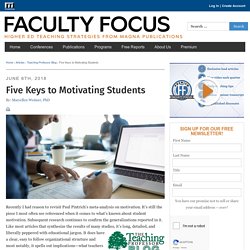
It’s still the piece I most often see referenced when it comes to what’s known about student motivation. Subsequent research continues to confirm the generalizations reported in it. Like most articles that synthesize the results of many studies, it’s long, detailed, and liberally peppered with educational jargon. It does have a clear, easy to follow organizational structure and most notably, it spells out implications—what teachers might consider doing in response to what the research says motivates students. Adaptive self-efficacy and competence perceptions motivate students. Motivation is sourced internally, but teachers can provide the fuel needed to power it. Reference: Pintrich, P. Implementing the Seven Principles: Technology as Lever. Implementing the Seven Principles: Technology as Lever (Source: A.W.
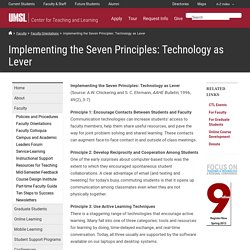
Chickering and S. C. Ehrmann, AAHE Bulletin, 1996, 49(2), 3-7) DEEP Practice Brief 6 What Faculty Members Can Do. What Faculty Members Need to Know about Retention. Online Student Readiness as a predictor of Online Student Satisfaction. Report strategies for increasing online student retention (1) eLearnReady (Free) – eLearning Assessment and Advising System. Current Issue of Online Classroom - September 2017. Facilitating Communities of Practice in Online Courses A community of practice is a network of people who exchange knowledge about a common profession.
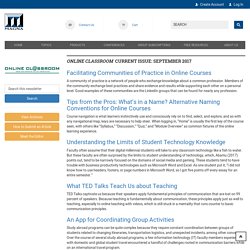
Members of the community exchange best practices and share evidence and results while supporting each other on a personal level. Good examples of these communities are the LinkedIn groups that can be found for nearly any profession. Tips from the Pros: What’s in a Name? Alternative Naming Conventions for Online Courses. Attracting and graduating a talented and high-achieving student body - Strategic Plan. Enroll, Retain, and Graduate at High Rates an Even More Talented and Accomplished Student Body During the next decade, the demographics of the college-going population will change dramatically.
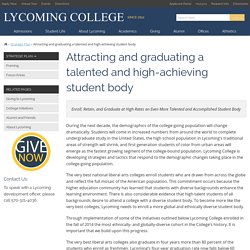
Students will come in increased numbers from around the world to complete undergraduate study in the United States, the high school population in Lycoming’s traditional areas of strength will shrink, and first generation students of color from urban areas will emerge as the fastest growing segment of the college-bound population. Lycoming College is developing strategies and tactics that respond to the demographic changes taking place in the college-going population. The very best national liberal arts colleges enroll students who are drawn from across the globe and reflect the full mosaic of the American population. This commitment occurs because the higher education community has learned that students with diverse backgrounds enhance the learning environment.
NSSE 2017 Academic Advising Module. WhyAssessStudentsMidYear. College Student Inventory, Student Retention Services, Student Engagement, College Freshman Survey. Use this early-alert survey to identify at-risk students, focus advisors on key concerns, and link students to resources The College Student Inventory identifies at-risk students in the incoming class using the leading noncognitive indicators of college student success.
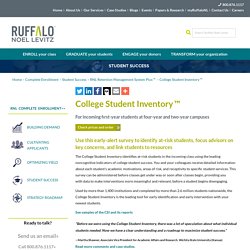
You and your colleagues receive detailed information about each student's academic motivations, areas of risk, and receptivity to specific student services. This survey can be administered before classes get under way or soon after classes begin, providing you with data to make interventions more meaningful and relevant, before a student begins disengaging. Used by more than 1,400 institutions and completed by more than 2.6 million students nationwide, the College Student Inventory is the leading tool for early identification and early intervention with your newest students. NSSE 2016 Annual Results. University Innovation Alliance. BestPracticesinCultivatingStudentCenterednessforWorkshop. 5 Insights to Increase Student Retention Infographic. 2017 National Freshman Motivation Report Addendum.
2017 National Freshman Motivation to Complete. RNL 2017 Student Retention Indicators. Student Success Report 1.0. Student Success, Retention, and Graduation Definitions, Theories, Practices, Patterns, and Trends. Er.educause. Re-Imagining the First Year of College. “Historically, AASCU and its members have been committed to student success with a particular concern for those students who have shown great promise but who have encountered stumbling blocks along the way.

The Re-Imagining the First Year of College initiative is further testament to this commitment. 5 a. Title3interventionreader. Twelve Best Practices for Student Engagement and Retention 2012. Early alerts as a tool for student success. Early Alert Systems in Higher Education. Early Alerts. Our Solutions. Title3interventionreader. BALL STATE UNIVERSITY 2017. CHE: Completion Dashboard. Memo: Improving and equalizing high school and college graduation rates for all students. Economists estimate that by 2020 more than two-thirds of jobs in the United States will require some form of postsecondary education or training.

However, at the current rate of higher education completion, the nation will fall nearly 20 million degrees short of meeting that need. According to The Pell Institute, in 2014 only 35 percent of 25-34 year olds had a bachelor’s degree or higher, placing the United States around the middle of 43 developed nations. Download a PDF of this memo Achieving economic competitiveness demands a national response to increase the number of people earning four-year degrees or credentials.
Moreover, the degree attainment rate masks pernicious inequities. Moreover, according to the Digest of Educational Statistics, Asians (57 percent) and whites (40 percent) are roughly twice as likely to hold a bachelor’s degree as African Americans (27 percent) and Hispanics (20 percent). The opportunity gap remains one ongoing challenge. Ball State improves on-time graduation rate, according to report. According to the 2017 College Completion Report released by the Indiana Commission for Higher Education, more Hoosier students are earning degrees and graduating on time.

Within the past five years, on-time graduation rates have increased by more than 11 percent and the completion gap between minority students and the overall student population has been cut nearly in half, according to a press release. “We’re encouraged that recent state policy reforms combined with the ongoing efforts of our campuses are having a clear impact in helping more students complete college,” said Teresa Lubbers Indiana Commissioner for Higher Education. The state goal is for 60 percent of Hoosiers to complete an education beyond high school by 2025.
Takeaways from the 2017 College Completion Report: How to Graduate on Time. In 2015, the standard university categories in the United States—“four-year” and “two-year”—are alarmingly inaccurate.

Es 20170426 increasing college completion with federal higher education matching grant pp deming. Thinking of Dropping out. Alternatives to Withdrawal Implications of Withdrawal So you have decided to quit Alternatives to Withdrawal Take a Short Break Have a good night's sleep, have a day off with friends, go for a long walk, engage in a little retail therapy - just relax.

Sometimes that is all that is needed to renew your energy and make you realise that you do not need to take any drastic steps. [ back to top ] Manage your Stress University studies are hard work and can be very stressful, especially if combined with work and family commitments. Get Back on Track If you are behind with your studies, borrow notes from friends, join a study group or talk to your lecturer to help you catch up the work you have missed. Improve your Study Skills Are you wanting to quit because the subject is too hard, the reading incomprehensible, the assignment too complicated, or because your notes are in a mess, you cannot organise your time and you keep procrastinating?
Why students drop pilot. Students and Enrollment - Fact Book. Ball State enrolls about 21,000 students, with more than 17,800 attending on campus. Students come from 48 states, two U.S. territories, about 43 countries, and every Indiana county. Out-of-state students make up about 13 percent of on-campus enrollment, and ethnic minorities comprise about 12 percent. The university enrolls more than 675 international students. Fall Enrollment Data: Five Year History. Overview of Ball State University Data & Information. Overview of Ball State University Data & Information.
HOW TO USE PEARLTREES. Early Warning Systems – American Institutes for Research. Completing College: A National View of Student Attainment Rates by Race and Ethnicity. First Year Persistence. Completing College A State Level View of Student Attainment Rates. How to improve student persistence and completion (essay) For years, our prevailing view of student retention has been shaped by theories that view student retention through the lens of institutional action and ask what institutions can do to retain their students.
Students, however, do not seek to be retained. They seek to persist. The two perspectives, although necessarily related, are not the same. Their interests are different. While the institution’s interest is to increase the proportion of their students who graduate from the institution, the student’s interest is to complete a degree often without regard to the college or university in which it is earned.
A practitioner’s guide to implementing early warning systems.